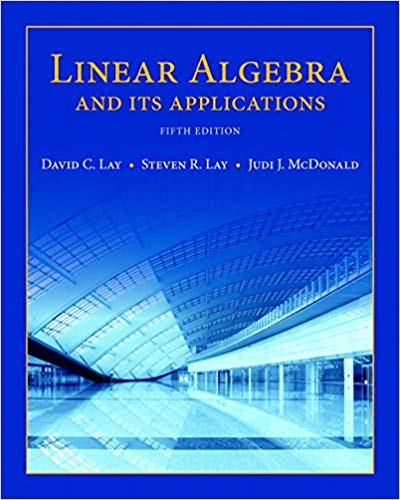
Linear Algebra and Its Applications, 5th Edition
Authors: David C. Lay, Steven R. Lay, Judi J. McDonald
ISBN-13: 978-0321982384
We have solutions for your book!
See our solution for Question 1E from Chapter 4.3 from Lay's Linear Algebra and Its Applications, 5th Edition.
Problem 1E
Chapter:
Problem:
Determine whether the sets in Exercises 1-8 are bases for...
Step-by-Step Solution
Step 1
Given set of Vectors\[\left\{ {\left[ {\begin{array}{*{20}{l}}1\\0\\0\end{array}} \right],\left[ {\begin{array}{*{20}{l}}1\\1\\0\end{array}} \right],\left[ {\begin{array}{*{20}{l}}1\\1\\1\end{array}} \right]} \right\}\]We have to find whether the given set of vectors are independent or form a basis for $R^3$.
Step 2: The matrix form
We can write the above set in Matrix form as\[\left[ {\begin{array}{*{20}{c}}1&1&1\\0&1&1\\0&0&1\end{array}} \right]\]The square matrix is in echelon form. We can also see that the matrix has 3 pivot elements, so the matrix is invertible. Moreover, by Invertible Matrix Theorem, for an invertible matrix of size $n \times n$, tThe columns of A form a basis for $R^n$ because they are linearly independent and they span $R^n$.
ANSWER
The given set of vectors are independent and form a basis for $R^3$
Given set of Vectors\[\left\{ {\left[ {\begin{array}{*{20}{l}}1\\0\\0\end{array}} \right],\left[ {\begin{array}{*{20}{l}}1\\1\\0\end{array}} \right],\left[ {\begin{array}{*{20}{l}}1\\1\\1\end{array}} \right]} \right\}\]We have to find whether the given set of vectors are independent or form a basis for $R^3$.
Step 2: The matrix form
We can write the above set in Matrix form as\[\left[ {\begin{array}{*{20}{c}}1&1&1\\0&1&1\\0&0&1\end{array}} \right]\]The square matrix is in echelon form. We can also see that the matrix has 3 pivot elements, so the matrix is invertible. Moreover, by Invertible Matrix Theorem, for an invertible matrix of size $n \times n$, tThe columns of A form a basis for $R^n$ because they are linearly independent and they span $R^n$.
ANSWER
The given set of vectors are independent and form a basis for $R^3$